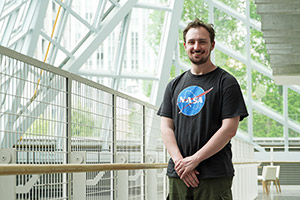

05/27/2024

In recent years, theoretical studies on non-Hermitian model systems have uncovered a diverse range of topological phases with intricate features. However, because much of the focus has been on single-particle systems, the exploration of interactions and correlations in shaping the topology of open, multi-particle quantum systems remains limited.
In a 2022 article, Faugno and Ozawa at AIMR introduced a novel theoretical approach for studying non-Hermitian Hamiltonians, aiming to bridge this gap1.
“Our work focuses of emergent phenomena in interacting systems, where a system exhibits unexpected behavior beyond the sum of its parts. This idea forms a cornerstone of modern many-body physics and has improved our ability to understand complex systems,” Faugno explains.
To explore this theme, the team developed a minimal one-dimensional chain model, incorporating a density-dependent dynamical gauge field to represent inter-particle interactions. They then proposed a two-frequency Floquet protocol to experimentally realize the model system, leading to the discovery of an emergent sublattice symmetry.
This approach both demonstrated the importance of dynamical gauge fields in shaping the behavior of nontrivial topological features, and confirmed the possibility of controlling the behavior of real quantum systems through external driving techniques—such as the Floquet experiment.
“The observed emergent symmetry confirmed that the investigation of non-Hermitian many-body systems can lead to the discovery of novel phenomena,” says Faugno. “This led to our recent study of the classical Hermitian limit where emergent chiral symmetry was found to play a key role2.”
Currently, the team is focusing on the out-of-equilibrium physics of the full many-body limit, where preliminary results have suggested the emergence of non-thermalizing scarring effects relevant to future memory-device applications.
(Author: Patrick Han)
This research highlight has been approved by the authors of the original article and all information and data contained within has been provided by said authors.